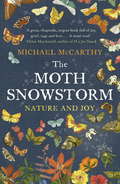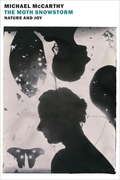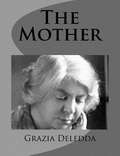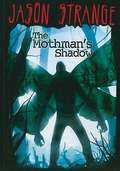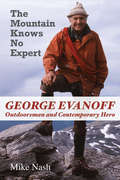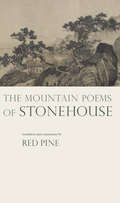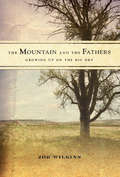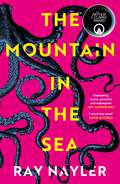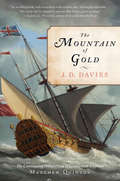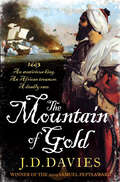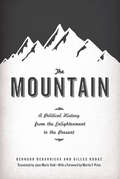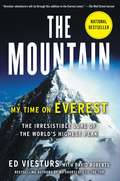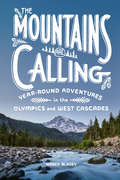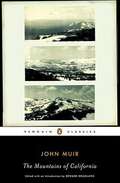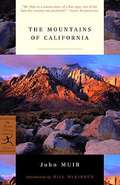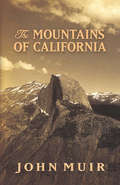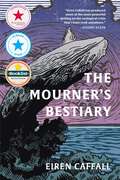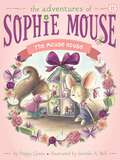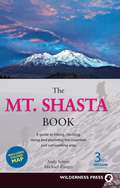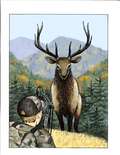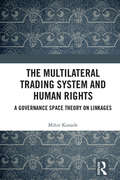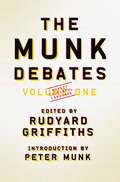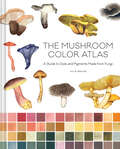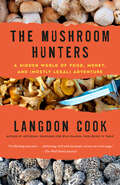- Table View
- List View
The Moth Snowstorm: Nature and Joy
by Michael McCarthyA great, rhapsodic, urgent book full of joy, grief, rage and love . . . A must-read' Helen Macdonald, author of H is for HawkNature has many gifts for us, but perhaps the greatest of them all is joy; the intense delight we can take in the natural world, in its beauty, in the wonder it can offer us, in the peace it can provide - feelings stemming ultimately from our own unbreakable links to nature, which mean that we cannot be fully human if we are separate from it. In The Moth Snowstorm Michael McCarthy, one of Britain's leading writers on the environment, proposes this joy as a defence of a natural world which is ever more threatened, and which, he argues, is inadequately served by the two defences put forward hitherto: sustainable development and the recognition of ecosystem services.Drawing on a wealth of memorable experiences from a lifetime of watching and thinking about wildlife and natural landscapes, The Moth Snowstorm not only presents a new way of looking at the world around us, but effortlessly blends with it a remarkable and moving memoir of childhood trauma from which love of the natural world emerged. It is a powerful, timely, and wholly original book which comes at a time when nature has never needed it more.
The Moth Snowstorm: Nature and Joy
by Michael MccarthyThe moth snowstorm, a phenomenon Michael McCarthy remembers from his boyhood when moths "would pack a car's headlight beams like snowflakes in a blizzard," is a distant memory. Wildlife is being lost, not only in the wholesale extinctions of species but also in the dwindling of those species that still exist.The Moth Snowstorm is unlike any other book about climate change today; combining the personal with the polemical, it is a manifesto rooted in experience, a poignant memoir of the author's first love: nature. McCarthy traces his adoration of the natural world to when he was seven, when the discovery of butterflies and birds brought sudden joy to a boy whose mother had just been hospitalized and whose family life was deteriorating. He goes on to record in painful detail the rapid dissolution of nature's abundance in the intervening decades, and he proposes a radical solution to our current problem: that we each recognize in ourselves the capacity to love the natural world.Arguing that neither sustainable development nor ecosystem services have provided adequate defense against pollution, habitat destruction, species degradation, and climate change, McCarthy asks us to consider nature as an intrinsic good and an emotional and spiritual resource, capable of inspiring joy, wonder, and even love. An award-winning environmental journalist, McCarthy presents a clear, well-documented picture of what he calls "the great thinning" around the world, while interweaving the story of his own early discovery of the wilderness and a childhood saved by nature. Drawing on the truths of poets, the studies of scientists, and the author's long experience in the field, The Moth Snowstorm is part elegy, part ode, and part argument, resulting in a passionate call to action.
The Mother
by Grazia DeleddaIn a remote Sardinian hill village, half civilized and superstitious. But the chief interest lies in the psychological study of the two chief characters, and the action of the story takes place so rapidly and the actual drama is so interwoven with the mental conflict, and all so forced by circumstances, that it is almost Greek in its simple and inevitable tragedy. The book is without offence to any creed or opinions, and touches on no questions of either doctrine or Church government. It is jut a human problem, the result of primitive human nature against man-made laws it cannot understand.
The Mother Lode
by John Austerman Judy Van WingerdenThe Automobile Club of Southern California has created a guide to traveling in one the most interesting historical areas of California - the stretch of mining towns known as the Mother Lode. Major communities in the area are described in detail.
The Mothman's Shadow
by Jason StrangeA camping trip goes horribly wrong for a group of teenage boys.
The Mountain Knows No Expert: George Evanoff, Outdoorsman and Contemporary Hero
by Mike NashShort-listed for the 2010 Banff Mountain Book Festival Competition The Mountain Knows No Expert epitomizes George Evanoff’s philosophy towards the outdoors, while presenting an intriguing contrast with the man himself. Widely regarded as an "expert," he was a knowledgeable, experienced, and practical outdoorsman, teacher, and mentor, yet ironically lost his life in the mountains in an encounter with a grizzly. Son of a Macedonian immigrant family, George was raised in Alberta, and went on to become a mountaineer, guide, avalanche specialist, and pioneer in ecotourism in British Columbias North Rockies. The many themes embedded in Evanoff’s life experiences encompass self-propelled backcountry travel, outdoor safety, avalanche safety and rescue, ski patrol leader, exploration and discovery, outdoor ethics, and public involvement with respect to land and resource use. George Evanoff was honoured in several tangible ways after his death, culminating in the naming of Evanoff Provincial Park in the Hart Ranges of the Rockies.
The Mountain Poems of Stonehouse
by Red Pine"The Mountain Poems of Stonehouse [is] a tough-spirited book of enlightened free verse. "#151;Kyoto Journal The Zen master and mountain hermit Stonehouse#151;considered one of the greatest Chinese Buddhist poets#151;used poetry as his medium of instruction. Near the end of his life, monks asked him to record what he found of interest on his mountain; Stonehouse delivered to them hundreds of poems and an admonition: "Do not to try singing these poems. Only if you sit on them will they do you any good. " Newly revised, with the Chinese originals and Red Pine's abundant commentary and notes, The Mountain Poems of Stonehouse is an essential volume for Zen students, readers of Asian literature, and all who love the outdoors. After eating I dust off a boulder and sleep and after sleeping I go for a walk on a cloudy late summer day an oriole sings from a sapling briefly enjoying the season joyfully singing out its heart true happiness is right here why chase an empty name Stonehouse was born in 1272 in Changshu, China, and took his name from a cave at the edge of town. He became a highly respected dharma master in the Zen Buddhist tradition. Red Pine is one of the world's leading translators of Chinese poetry. "Every time I translate a book of poems," he writes, "I learn a new way of dancing. And the music has to be Chinese. " He lives near Seattle, Washington.
The Mountain and the Fathers: Growing Up on The Big Dry
by Joe WilkinsThe Mountain and The Fathers explores the life of boys and men in the unforgiving, harsh world north of the Bull Mountains of eastern Montana in a drought afflicted area called the Big Dry, a land that chews up old and young alike. Joe Wilkins was born into this world, raised by a young mother and elderly grandfather following the untimely death of his father. That early loss stretches out across the Big Dry, and Wilkins uses his own story and those of the young boys and men growing up around him to examine the violence, confusion, and rural poverty found in this distinctly American landscape. Ultimately, these lives put forth a new examination of myth and manhood in the American west and cast a journalistic eye on how young men seek to transcend their surroundings in the search for a better life. Rather than dwell on grief or ruin, Wilkins' memoir posits that it is our stories that sustain us, and The Mountain and The Fathers, much like the work of Norman MacClean or Jim Harrison, heralds the arrival of an instant literary classic.
The Mountain in the Sea
by Ray Nayler'I loved this novel's brain and heart'DAVID MITCHELL, AUTHOR OF CLOUD ATLAS'A first-rate speculative thriller, by turns fascinating, brutal, powerful, and redemptive'JEFF VANDERMEER, AUTHOR OF ANNIHILATIONThere are creatures in the water of Con Dao. To the locals, they're monsters. To the corporate owners of the island, an opportunity. To the team of three sent to study them, a revelation. Their minds are unlike ours. Their bodies are malleable, transformable, shifting. They can communicate. And they want us to leave.When pioneering marine biologist Dr. Ha Nguyen is offered the chance to travel to the remote Con Dao Archipelago to investigate a highly intelligent, dangerous octopus species, she doesn't pause long enough to look at the fine print. DIANIMA- a transnational tech corporation best known for its groundbreaking work in artificial intelligence - has purchased the islands, evacuated their population and sealed the archipelago off from the world so that Nguyen can focus on her research.But the stakes are high: the octopuses hold the key to unprecedented breakthroughs in extrahuman intelligence and there are vast fortunes to be made by whoever can take advantage of their advancements. And no one has yet asked the octopuses what they think. And what they might do about it.
The Mountain of Gold
by J. D. DaviesBeset by pirates, Knights of Malta, and saboteurs, Matthew Quinton sails to Africa in this buoyant sequel to Gentleman Captain.When a captured Barbary pirate saves his neck with the story of a fabled mountain of gold, Captain Matthew Quinton has his doubts. But King Charles II can't resist the chance to outstrip the Dutch with a limitless source of wealth. With the devious corsair aboard, Quinton embarks on a voyage beyond the map's edge, still convinced that the mountain is mere legend. But as attempts to sabotage his mission draw closer to the mark, he begins to wonder ...Back in England, the king has arranged a wedding between Matthew's elder brother, the Earl of Ravensden, and a mysterious lady rumored to have murdered her previous two husbands. Resolved not to fail his meddlesome sovereign, and to return home in time to protect his family and his home, Captain Quinton approaches the coast of Africa with a troubled mind.
The Mountain of Gold (The Matthew Quinton Journals)
by J. D. Davies&“Swashbuckling suspense, royal intrigue, and high seas naval action&” abound in this saga of a Royal Navy captain&’s search for treasure in Africa (Publishers Weekly). 1663: Captain Matthew Quinton is thrilled to capture a corsair from under the nose of menacing Maltese Knight Montnoir. But his triumph is short lived. The &“pirate&” is in fact the infamous Irish adventurer O&’Dwyer, who comes with talk of a vast West African gold mine . . . Ordered by the avaricious King Charles to accompany O&’Dwyer to Africa and unearth the gold, Quinton sets sail for the Gambia. Dogged by misfortune, with sabotage and murder darkening the mission, Quinton discovers Montnoir is on his trail. The race for gold will put everything at risk . . . Can Quinton emerge in one piece?The Mountain of Gold is the second novel in the thrilling Matthew Quinton Journals naval adventure series. Praise for the writing of J.D. Davies: &“Hornblower, Aubrey and Quinton—a pantheon of the best adventures at sea!&” —Conn Iggulden, #1 New York Times–bestselling author of The Conqueror and War of the Roses series &“A hero worth rooting for.&” —Publishers Weekly &“Utterly impossible to put down . . . Finely-shaded characters, excellent plotting, gut-clenching action and immaculate attention to period detail . . . Superb.&” —Angus Donald, author of The Outlaw Chronicles series &“Destined to be a classic of nautical adventure series.&” —Eric Jay Dolin, author of Leviathan and Fur, Fortune, and Empire &“A naval adventure that goes well beyond the usual outlines of the genre to paint a lively portrait of England in the 1600s.&” —Kirkus Reviews
The Mountain: A Political History from the Enlightenment to the Present
by Bernard Debarbieux Gilles RudazIn The Mountain, geographers Bernard Debarbieux and Gilles Rudaz trace the origins of the very concept of a mountain, showing how it is not a mere geographic feature but ultimately an idea, one that has evolved over time, influenced by changes in political climates and cultural attitudes. To truly understand mountains, they argue, we must view them not only as material realities but as social constructs, ones that can mean radically different things to different people in different settings. From the Enlightenment to the present day, and using a variety of case studies from all the continents, the authors show us how our ideas of and about mountains have changed with the times and how a wide range of policies, from border delineation to forestry as well as nature protection and social programs, have been shaped according to them. A rich hybrid analysis of geography, history, culture, and politics, the book promises to forever change the way we look at mountains.
The Mountain: My Time on Everest
by Ed ViestursIn national bestseller The Mountain, world-renowned climber and bestselling author Ed Viesturs and cowriter David Roberts paint a vivid portrait of obsession, dedication, and human achievement in a true love letter to the world’s highest peak.In The Mountain, veteran world-class climber and bestselling author Ed Viesturs—the only American to have climbed all fourteen of the world’s 8,000-meter peaks—trains his sights on Mount Everest in richly detailed accounts of expeditions that are by turns personal, harrowing, deadly, and inspiring. The highest mountain on earth, Everest remains the ultimate goal for serious high-altitude climbers. Viesturs has gone on eleven expeditions to Everest, spending more than two years of his life on the mountain and reaching the summit seven times. No climber today is better poised to survey Everest’s various ascents—both personal and historic. Viesturs sheds light on the fate of Mallory and Irvine, whose 1924 disappearance just 800 feet from the summit remains one of mountaineering’s greatest mysteries, as well as the multiply tragic last days of Rob Hall and Scott Fischer in 1996, the stuff of which Into Thin Air was made. Informed by the experience of one who has truly been there, The Mountain affords a rare glimpse into that place on earth where Heraclitus’s maxim—“Character is destiny”—is proved time and again.
The Mountains Are Calling: Year-Round Adventures in the Olympics and West Cascades
by Nancy BlakeyLooking for easily accessible yet off-the-beaten-path outdoor adventures you can do year-round in the mountains near Seattle, Portland, and Bend? Look no further!Imagine escaping to old-growth forests, snow-capped peaks, waterfalls, and hot springs. This beginner-friendly guide will show you where to go, what to do, and what to look for while you&’re there. Covering the Olympics and West Cascades (Olympic Peninsula, Mount Baker, Central Cascades, Mount Rainier, Mount St. Helens, Mount Hood, Deschutes National Forest, and Crater Lake) the book features a robust basics section with tips, gear guides, nature ID, geology, and safety info. Each mountain location includes background information, getaways (to campgrounds, cabins, lodges, fire lookouts, and yurts), and activities (green season and snow season). Green season features spring/summer/fall hikes and backpacking trips, while snow season includes downhill skiing, snowboarding, cross country skiing, snowshoeing, winter hikes, and more. Activities are coded with icons (accessible, near campground, wildflower, berry picking, bird watching, dogs allowed, wow-factor, waterfall) and are indexed by icon at the end. This book will inspire you to get outdoors all year long with beautiful photography and illustrations, evocative descriptions, maps, and all the basics you need to know to go.
The Mountains of California
by John Muir Edward HoaglandA stirring tribute to one of America's most remote and beautiful places by one of the first modern preservationists This Penguin Classic-Muir's first book-puts a pioneering conservationist's passion for nature in high relief. With a poet's sensitivity and a naturalist's eye, Muir celebrates the Sierra Nevada, which he dedicated his life to saving, and recounts his breathtaking visits to Yosemite Valley, Kings Canyon, Sequoia Groves, and Mount Whiskey. The Mountains of California is an affecting celebration of raw nature by one of its most ardent defenders.
The Mountains of California
by John MuirA reprint of the Century Co. edition of 1894 with illustrations added from Picturesque California and the region west of the Rockies.
The Mountains of California (Large Print Ser.)
by John MuirA great hero of America's conservation movement, John Muir (1838–1914) was active in establishing the Yosemite Valley as a protected national park and in awakening interest in the importance of safeguarding natural resources. In this tribute to the grandeur of the Sierras, Muir recounts his journeys by foot through the Yosemite Valley, Mount Whitney, the famed sequoia forests, King's Canyon, and other wilderness areas. With a natural historian's keen eye for flora, geography, and geology, Muir describes glaciers, lakes, trees, and the daily lives of the region's inhabitants. His lyrical narrative, imbued with the deepest understanding and respect for nature, examines the ways in which natural forces shape the landscape and the effects of the changing seasons. The zesty travelogue is accompanied by splendid illustrations of maps, plants, and animals. Originally published in 1894, The Mountains of California continues to delight and inform readers.
The Mourner's Bestiary
by Eiren CaffallA critically-acclaimed literary memoir braiding together environmental research and the personal journey of generational healing, grief, and chronic illness.Author Eiren Caffall is the inheritor of a family legacy of two hundred years of genetic kidney disease and the mother of a child who may inherit that legacy. A literary memoir on loss, chronic illness, and generational healing, Caffall&’s The Mourner&’s Bestiary is also a meditation on grief and survival told through the stories of animals in two collapsing marine ecosystems—the Gulf of Maine and the Long Island Sound—and the lives of a family facing a life-threatening illness on their shores. The Gulf of Maine is the world&’s fastest-warming marine ecosystem, and the Long Island Sound has been the site of conservation battles that predict the fights ahead for the Gulf. "Beguiling, idiosyncratic [...] Caffall writes with plangent intensity about our responsibility toward the planet, and her eye for the wonder and beauty of ocean life pierces the illusion of disconnected existence." ? Whiting Creative Nonfiction Grant judges citation "Eiren Caffall has produced some of the most powerful writing on the ecological crisis I have read anywhere. Caffall is a gifted writer, and this book is strong medicine." ? Naomi Klein, author, social activist, and filmmaker
The Mouse House: The Great Big Paw Print; It's Raining, It's Pouring; The Mouse House; Journey To The Crystal Cave (The Adventures of Sophie Mouse #11)
by Poppy GreenAt a birthday party, Sophie feels jealous when her friend gets a present that she’s been wanting in this eleventh charming book of The Adventures of Sophie Mouse series!Sophie is so excited to go to her friend Ellie’s birthday party. She loves birthday parties. She always paints her friends beautiful cards and she loves playing party games. When Ellie gets a mouse house—a little house with teeny-tiny mouse dolls and teeny-tiny furniture—Sophie tries to be happy for her friend but she actually feels very jealous. She’s always wanted a mouse house! As Sophie tries to deal with these feelings, she learns that not everybody gets what they want and not everybody wants what they have! With easy-to-read language and illustrations on almost every page, the Adventures of Sophie Mouse chapter books are perfect for beginning readers.
The Mt. Shasta Book
by Andy Selters Michael ZangerThe Mt. Shasta Book is the ultimate guide to safely the hiking, backpacking, and climbing routes up the 14,162-foot mountain. In addition, this guide covers the area's skiing, snowboarding, water activities, and mountain biking trails. With over 50 combined years of experience as Shasta guides, the authors are seasoned experts on the mountain and its surroundings. The print edition comes with a fold-out 4-color topographic map.
The Muddy Elk (Lucky Luke's Hunting Adventures)
by Kevin LovegreenA perfect day on a magical lake filled with fish. The smell of pine trees, the bright sunshine, a nice breeze: the stage is set for a great adventure! Join Luke at his grandparents' lake cabin, tucked way back in the woods, as he experiences an amazing morning of fishing. Luke has to find the hot spots, pick the right lures, and chase a lunker that steals his lucky Basserino. It's the kind of morning anyone who's ever held a rod dreams of!
The Multilateral Trading System and Human Rights: A Governance Space Theory on Linkages
by Mihir KanadeThis book contributes an original theory to understanding human rights and international trade. It offers the ‘governance space’ framework for analysing the linkages and normative relationships between the multilateral trading system (MTS) and human rights regimes. Drawing upon key case studies, the author identifies connecting strands as also gaps in linkage issues. He further examines the ‘right to development’ approach to resolve tensions between these two regimes and demonstrates how the approach may be the most appropriate road map to finding sustainable solutions in balancing human rights and equitable free trade in a complex globalised world. Presenting new legal analyses informed by current debates drawn from international organisations – the World Trade Organization, United Nations, International Labour Organization – governments, civil society and academia as well as global commitments such as the Sustainable Development Goals, the book proposes a systematic and holistic policy intervention. This timely and transdisciplinary text will be of great interest to academics, students and scholars of human rights, international trade, international law, development studies, public policy and governance, economics, politics and international relations. It will also be useful to policymakers, think-tanks, human rights advocates, professionals, lawyers, civil society organisations, non-governmental organisations and trade experts.
The Munk Debates (The Munk Debates)
by Rudyard GriffithsThe Munk Debates is Canada's premier international debate series, a highly anticipated cultural event and feast of ideas. Launched in 2008 by philanthropists Peter and Melanie Munk, these debates bring together some of the world's greatest thinkers to discuss the most pressing political, social, and cultural issues that are shaping the course of world events. This volume includes an Introduction by Peter Munk and the first five debates in the series: British historian and bestselling author Niall Ferguson, top-ranking American diplomat Richard Holbrooke, Washington Post columnist Charles Krauthammer, and human rights scholar and Pulitzer Prize-winning author Samantha Power discuss global security and the 2008 U.S. presidential election, Former U.S. Ambassador to the United Nations John Bolton, former Foreign Minister of the Australian Parliament and President and Chief Executive of the International Crisis Group Gareth Evans, actor and humanitarian Mia Farrow, and former Chief of the Defence Staff of the Canadian Forces General Rick Hillier debate the pros and cons of humanitarian intervention. Professor of Economics Paul Collier, economist Hernando De Soto, former UN Secretary-General Stephen Lewis, and bestselling author of Dead Aid Dambisa Moyo explore the opportunities and hazards of foreign aid. Former British politician and bestselling author Lord Nigel Lawson, adjunct professor at the Copenhagen Business School and bestselling author Bjørn Lomborg, environmental activist and Leader of the Green Party of Canada Elizabeth May, and journalist and bestselling author George Monbiot tackle one of the great public policy questions of our time: how should the world respond to climate change? Intelligent, informative, and entertaining, The Munk Debates is a lively forum of ideas and opinions that aims to reinvigorate public discourse and civic dialogue, and captures the prevailing moods, clashing opinions, and most imperative issues of our time.
The Mushroom Color Atlas: A Guide to Dyes and Pigments Made from Fungi
by Julie BeelerDiscover the chromatic wonders of the fungi kingdom and the incredible spectrum of pigments and dyes that can be created from mushrooms. "This stunning book is the result of years of creative experimentation. Mushrooms are chemical wizards, and Julie Beeler is a masterful guide to the spectrum of pigments they can make. I have spent many happy moments lost in the fungal colorscapes contained in this exquisitely produced volume." ―Merlin Sheldrake, author of Entangled LifeMore closely related to humans than they are to plants, fungi are fascinating organisms—and they are a rich resource for color collectors! Blending scientific detail, botanical illustrations, and creative inspiration, artist and educator Julie Beeler invites you to peek into her workroom as she introduces different types of dye mushrooms—from boletes to polypores to tooth fungi—and walks you through her color-harvesting process. Offering insightful tips on foraging and color distillation and a rainbow of color samples, Beeler peppers in down-to-earth advice on artistic experimentation and fascinating stories about the historical and personal connections between humans and nature, offering a fresh perspective on the magical world of mushrooms.UNIQUE FIELD GUIDE TO MUSHROOMS: This guide will take you on a vibrant journey through identifying and collecting dye mushrooms to distilling an astonishing range of colors from each one. The five hundred color swatches included in these pages showcase an astounding array of natural dyes and pigments made from mushrooms. A PRACTICAL AND INSPIRATIONAL GUIDE: The Mushroom Color Atlas combines step-by-step instructions for hands-on color creation with impressive hues and eye-catching palettes. Whether you're a working designer or an emerging artist, a full-time forager or an armchair mycologist, you will find something to love in this unique exploration of science and color. GO NATURAL: The rewarding hands-on experience of working with mushroom dyes and pigments is a powerful way to feel intimately connected to nature. Beeler invites readers to forge their own creative connection to the natural world, offering advice on ethical foraging, artistic experimentation, and the abundant possibilities afforded to us by the small but mighty mushroom.Perfect for: Mushroom enthusiasts, foragers, amateur mycologists, and nature lovers Artists; fashion, graphic, and interior designers; any professional who incorporates color into their work Crafters and creative hobbyists Color enthusiasts and people interested in natural dyes and pigments Anyone interested in sustainable fashion and textile arts
The Mushroom Hunters: On the Trail of an Underground America
by Langdon CookIn the tradition of Michael Pollan's The Omnivore's Dilemma, Susan Orlean's The Orchid Thief, and Mark Kurlansky's Cod--a renowned culinary adventurer goes into the woods with the iconoclasts and outlaws who seek the world's most coveted ingredient . . . and one of nature's last truly wild foods: the uncultivated, uncontrollable mushroom.Within the dark corners of America's forests grow culinary treasures. Chefs pay top dollar to showcase these elusive and beguiling ingredients on their menus. Whether dressing up a filet mignon with smoky morels or shaving luxurious white truffles over pasta, the most elegant restaurants across the country now feature an abundance of wild mushrooms. The mushroom hunters, by contrast, are a rough lot. They live in the wilderness and move with the seasons. Motivated by Gold Rush desires, they haul improbable quantities of fungi from the woods for cash. Langdon Cook embeds himself in this shadowy subculture, reporting from both rural fringes and big-city eateries with the flair of a novelist, uncovering along the way what might be the last gasp of frontier-style capitalism. Meet Doug, an ex-logger and crabber--now an itinerant mushroom picker trying to pay his bills and stay out of trouble; and Jeremy, a former cook turned wild food entrepreneur, crisscrossing the continent to build a business amid cutthroat competition; their friend Matt, an up-and-coming chef whose kitchen alchemy is turning heads; and the woman who inspires them all. Rich with the science and lore of edible fungi--from seductive chanterelles to exotic porcini--The Mushroom Hunters is equal parts gonzo travelogue and culinary history lesson, a rollicking, character-driven tour through a world that is by turns secretive, dangerous, and tragically American.Praise for The Mushroom Hunters "Like Susan Orlean in The Orchid Thief, Seattle author [Langdon] Cook shines a light on a shady subculture operating at the seam between wilderness and commerce. Like author Michael Pollan, he knows that every bite of food these days has a complex, often unsavory backstory. Like the late Hunter Thompson, he not only goes along for the ride with the shifty characters he's writing about, but drives the getaway car. After reading The Mushroom Hunters, you'll never look at a portobello the same way. . . . [A] beguiling, surprising book."--The Seattle Times "Not simply about mushrooms, this book examines human behavior, economics, food, society, and nature. In the end, readers will have learned a great deal about U.S. economic and social structures--all while being entertained and enlightened by stories of gastronomy and mushrooms. Highly recommended."--Library Journal "Intrepid and inspired."--Publishers Weekly "Uncultivated mushrooms are one of our last truly wild food; it often takes truly wild and rough mushroom hunters to bring them to our table. Cook travels and hunts with them in a riveting, crazy undertaking, told in often-poetic prose."--Shelf Awareness "Cook's sketches of these unique and idiosyncratic characters aren't always wholly sympathetic, but he makes every one of them real."--Booklist"If you've never thought of using the words 'mushroom' and 'adventure' in the same sentence, this gripping book will force you to reconsider."--Bill McKibben, author of Oil and Honey: The Education of an Unlikely ActivistFrom the Hardcover edition.
